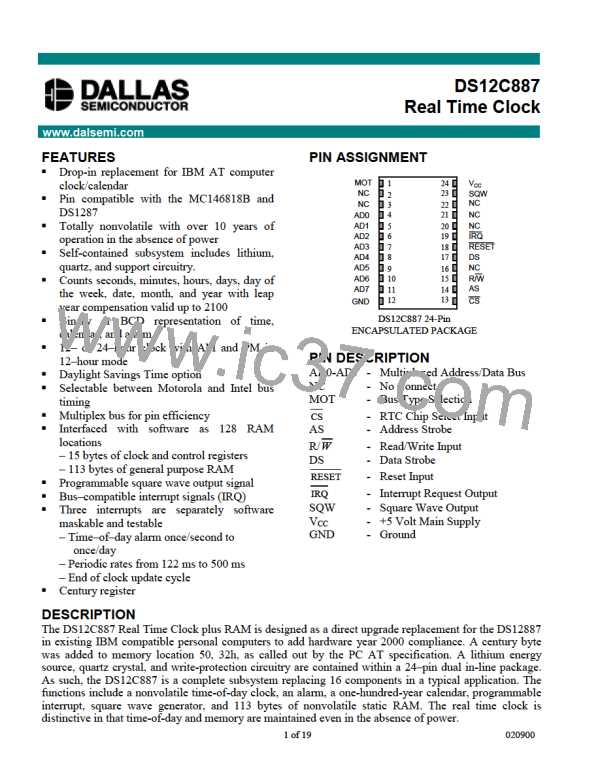DS12C887
TIME, CALENDAR AND ALARM LOCATIONS
The time and calendar information is obtained by reading the appropriate memory bytes. The time,
calendar, and alarm are set or initialized by writing the appropriate RAM bytes. The contents of the ten
time, calendar, and alarm bytes can be either Binary or Binary-Coded Decimal (BCD) format. Before
writing the internal time, calendar, and alarm registers, the SET bit in Register B should be written to a
logic one to prevent updates from occurring while access is being attempted. In addition to writing the ten
time, calendar, and alarm registers in a selected format (binary or BCD), the data mode bit (DM) of
Register B must be set to the appropriate logic level. All ten time, calendar, and alarm bytes must use the
same data mode. The set bit in Register B should be cleared after the data mode bit has been written to
allow the real time clock to update the time and calendar bytes. Once initialized, the real time clock
makes all updates in the selected mode. The data mode cannot be changed without reinitializing the ten
data bytes. Table 2 shows the binary and BCD formats of the ten time, calendar, and alarm locations. The
24–12 bit cannot be changed without reinitializing the hour locations. When the 12–hour format is
selected, the high order bit of the hours byte represents PM when it is a logic one. The time, calendar,
and alarm bytes are always accessible because they are double buffered. Once per second the eleven bytes
are advanced by one second and checked for an alarm condition. If a read of the time and calendar data
occurs during an update, a problem exists where seconds, minutes, hours, etc. may not correlate. The
probability of reading incorrect time and calendar data is low. Several methods of avoiding any possible
incorrect time and calendar reads are covered later in this text. The three alarm bytes can be used in two
ways. First, when the alarm time is written in the appropriate hours, minutes, and seconds alarm
locations, the alarm interrupt is initiated at the specified time each day if the alarm enable bit is high . The
second use condition is to insert a “don’t care” state in one or more of the three alarm bytes. The “don’t
care” code is any hexadecimal value from C0 to FF. The two most significant bits of each byte set the
“don’t care” condition when at logic 1. An alarm will be generated each hour when the “don’t care” bits
are set in the hours byte. Similarly, an alarm is generated every minute with “don’t care” codes in the
hours and minute alarm bytes. The “don’t care” codes in all three alarm bytes create an interrupt every
second.
TIME, CALENDAR AND ALARM DATA MODES Table 1
ADDRESS
LOCATION
FUNCTION
DECIMAL
RANGE
RANGE
BINARY DATA MODE
BCD DATA MODE
O
1
2
3
4
Seconds
0-59
0-59
0-59
0-59
1-12
0-23
1-12
0-23
1-7
00-3B
00-59
00-59
Seconds Alarm
Minutes
00-3B
00-3B
00-59
Minutes Alarm
Hours 12-hr, Mode
Hours 24-hr, Mode
Hours Alarm 12-hr, Mode
Hours Alarm 24-hr, Mode
Day of the week Sunday=1
Date of Month
Month
00-3B
00-59
01-0C AM, 81-8C PM
01-12 AM, 81-92 PM
00-23
00-17
5
01-0C AM, 81-8C PM
01-12 AM, 81-92 PM
00-23
00-17
01-07
01-1F
01-0C
00-63
NA
6
7
01-07
1-31
1-12
0-99
0-99
01-31
8
01-12
9
Year
00-99
50
Century
19,20
6 of 19

 DALLAS [ DALLAS SEMICONDUCTOR ]
DALLAS [ DALLAS SEMICONDUCTOR ]